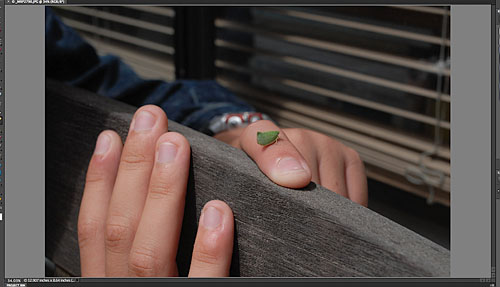MAC GETS ORGANIZER, PREMIERE
Feature: Elements 9 --
Magic Kit for Photos & Movies

By MIKE PASINI
Editor
The Imaging Resource Digital Photography Newsletter
Review Date: September 2010
Ah, how the world turns. Once upon a time Adobe's Elements package was one of the best ways to learn about digital photography.
"Nothing quite prepares you for image editing. It isn't obvious what you can do or how to go about it. Elements makes that about as clear as it can be made," we wrote in our review of Photoshop Elements 1.0.
So last century.
These days what you need is magic. If you can't afford the big-tent abracadabra of something like Photoshop CS5, don't despair. Just pony up for the affordable Elements magic kit and amaze your friends.
"Wow!" they will say. "Amazing!" they will gasp.
We know because that's what all us press people were saying during the Adobe briefing last week for Photoshop/Premiere Elements 9.
PHOTOS & MOVIES | Back to Contents
The first thing to clear up is that this release is, like your digicam, about both photos and movies. You can buy Photoshop Elements alone or Premiere Elements by itself, but the bundle is almost the same price. So we're calling it Elements 9, period.
And if you're a Mac aficionado and therefore wary of that line, let us reassure you Elements 9 is a different ball game than Elements 8. You get what Windows magicians have been getting all along: the Organizer, Premiere, the whole ball of wax.
So if you don't know much about image editing and you do want to create eye-popping special effects with both your photos and your movies, Elements 9 is the magic kit you want. Even, we dare say, if you own the Creative Suite already.
And to prove it, we'll leave the dry stuff for the end and hit the crowd pleasers up front.
That starts with movies. Premiere Elements Product Manager Mike Iampietro took us through some very impressive features not seen together in lesser products.
We long ago chided Adobe for whining like the little kid next door that "they made me lose" when it withdrew from the Mac hobbyist market in the face of iLife. So let us welcome Adobe back warmly, with applause for its superior movie editor in Premiere Elements.
Import. Iampietro explained that problem number uno for them was those of us who love to take movies with our handcams, digicams and cellphones. We don't use tape. We don't use those bulky video recorders that are so last century. We use cool little devices that are always handy when stuff happens.
And that have a million different ways of compressing the data they capture, unfortunately. Adobe had to work hard under the hood, Iampietro said, to make it possible to import everything from AVI to MOV to AVCHD into Premiere Elements. And it does it without transcoding the import from its native language to a more generic one. Nope, no transcoding, just the original encoding. So it's fast and natural.
We think that's a good example of one of Adobe's best virtues. The guys developing the product actually use it. They build what they need. A lesser company might have this shiny whiteboard blinding their developers that shows how much less work would be involved for them if they just transcoded everything into one format and dealt with that. The user gets the lowest common denominator but how can they tell anyway?
At Adobe the developers are users. They want the benefits of doing it the best way.
Those benefits include being able to preview your clips on your connected device before importing, renaming the clip (so, you know, you know) and picking a theme (or style) to create an InstantMovie right away (in case you have homework to do).
Also new in 9, Adobe told us, is facial recognition for movies with workflows that can be driven by which people appear in the movies.
Audio. The second thing Adobe spent some man years on is The Great Problem With Cheap Camcorders or, in a word, Audio. You can put up with very degraded video if the audio is pristine but you can't really enjoy a movie if the audio isn't clean. It's a law of thermodynamics or something. No way around it.
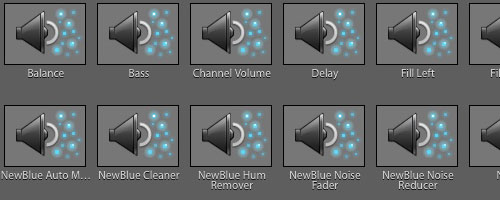
Audio Filters. Just a few of the many ways to clean up your audio.
Adobe's solution in Premiere Elements 9 is a set of filters to clean up audio. You just drag and drop them on your timeline. Very cool. Even if your friends won't gasp in wonder, they will stay out of your refrigerator and keep their eyes on the screen.
Video Effects. Same magic for video as audio, though. Drag and drop filters. But here Adobe had more fun, we think. They didn't just clean up video. They transformed it.

Cartoon Effect. One-click magic.
Remember those financial service TV ads that looked like illustrations but were uncannily life-like? You can do that in Premiere Elements 9 just by dragging the Cartoon video effect on your timeline.
This may mean we can all be bankers and get out of this economic mess we're in.
The effect is smart enough to look for edges and turn them into lines while posterizing colors. Even better, you can enhance or dampen the effect using sliders. And when you get it just the way you want, you can save it as a preset so you can use it again on the sequel.
And when your friends see that one, fellow movie makers, they will indeed gasp. And then they will bow down before you offering alms.
Sharing. Adobe's research division (wearing team T-shirts under their dry-clean-only white lab coats) knows the dirty truth is we still share our movies by burning them on DVDs and schlepping them over to the DVD player plugged into our TV. Just like, well, the last century.
The Premiere Elements team passes no judgment on that. They're users, too, guilty of the same crime. But if we all want to make DVDs, they figure, we should have DVD menus with an automatic Scene Index so we can author and burn in one app on our machine.
But they've also dropped in a new way to share, which they call WebDVD. This bundles the movie and menus in a tight little package you can upload to any of the sharing sites Elements supports (and there are nearly too many to mention, but we do in the next section).
The only catch here is that the little bundle is brought to you by the Flash team, according to the T-shirts under their lab coats. The movie is converted to Flash, the menus to Flash and a bundled SWF player wraps the whole thing up. So no playback on iPhones or iPads. And Droids may stumble. But not until the next century. Adobe has been working hard on its Flash players recently (http://www.blackcj.com/blog/2010/09/17/flash-outperforms-html5-on-mobile-devices/).
SAY CHEESE! | Back to Contents
Those of us who love taking still photos may be a little envious of all the glitz in Premiere Elements 9, but there's no need for such childish behavior. After all, you can get Premiere bundled in the same box (both Mac and Windows versions, too) and it will make us look just as clever as any indie editor without the Goth getup.
But we get our own magic tricks, too. Photoshop Elements Product Manager Bob Gager took us through them.
Stories. Trend Number One is storytelling. In the still world, this looks like a sequence of photos (a slide show) with embellishments that may end up as a photo book (you know, where the captions can be verbose).
So sharing has been expanded to include Facebook, joining Photoshop.com, Kodak, Flikr, YouTube, SmugMug, Shutterfly and Podbean.com. You're not locked into Photoshop.com with Elements 9. And you can add images to an existing album or create a new one.
And Elements is smart enough that when you upload a set of images, it won't upload the full resolution images that the site subsequently downsizes for Web display. Instead, it resizes the images to the site's preferences and then uploads them so they get there quickly.
And the book layout feature has been stripped to the studs and remodeled with granite kitchen counters and brushed nickel fixtures. You can print books on your inkjet or use Kodak Gallery or Shutterfly publishing.
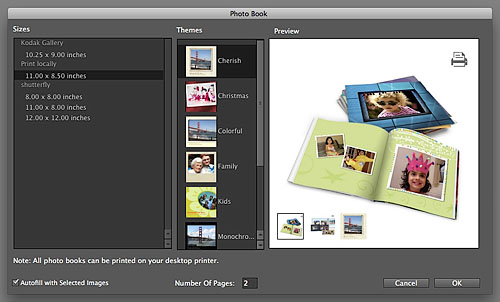
Photo Books. Print at home, Kodak Gallery or Shutterfly using templates for layout.
But you don't have to go that far to enjoy the new Elements user interface with -- drum roll and wildly applauding audience -- larger type. Yes, Adobe researchers have realized that some Elements users have crossed over the Age 40 Divide and can not make out miniscule type on their 130-dpi monitors without those cheap magnifier glasses from CVS that make everyone look like a librarian.
Not that there's anything wrong with librarians.
Organizing. In fact, Mac users may find the new Organizer a lot more fun than Lightroom or iPhoto, offering easy ways to tag images for retrieval later (when you can't remember what you shot when or where).
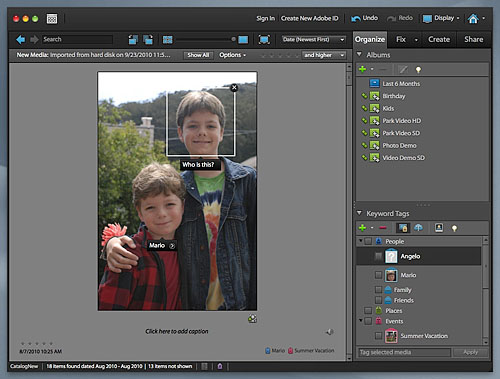
Organizer. Face recognition and easy tagging.
We actually found ourselves starting to enjoy tagging images in Organizer. Most of the time this feels like picking your socks up off the floor, but in Organizer it seemed more like putting extra onions and relish on your Polish.
Guided Edits. But the real fun in Photoshop Elements 9 is in the new Guided Edits. There are a handful of them. Here's their names (which won't tell you much but proves we were paying attention): Out of Bounds (where some part of the main subject sticks out past the borders of the image), Lomo Camera (cross-processed colors with vignetting so people think you still shoot film with a $30 camera), Pop Art (which continues to pop), Reflection (which reflects you image down into water or glass with several gradations of smoothness) and Portrait Touchup (which smooths skin, whitens teeth, remove blemishes and otherwise puts your plastic surgeon to shame).
They're called Guided Edits and not One-Click Wonders for a reason. They take a few steps, all fully explained in the right column as you work through the trick. The best magic tricks -- like sawing a woman in half -- are like that.
So for Out of Bounds (just to take Gager's example), you set a frame inside your image that lets a few features of your subject stick out (say, a head and a surfboard). Then you add a little perspective to the frame so it looks like its coming at you a bit from the side instead of blocking your way. Then you just drag out a little border for the frame so it will look like a photo. Next you just mouse over the parts you want to extend outside the frame (that head, that surfboard). And finally, you fiddle around with a shadow and a gradient if you want.
And your friends drop their jaws in one simultaneous, "Wow! How'd you do that?"
Don't tell them it was a guided edit, please. It discredits the profession. They know it's magic. Let them believe.
Content Aware Fill. Even more exciting, though, is the magic Elements has borrowed from Photoshop CS5. And, yes, we mean content-aware fills!
Healing Brush Menu. Note the Content Aware option.
As we mentioned in our Photoshop CS preview, "There are a lot of snapshots that could stand removing some protruding element that could not have been avoided at the time. In fact, don't be surprised to see this show up in Photoshop Elements. 'We have a pretty good history of sharing technology between the two applications. That certainly goes both ways,' Bryan [Photoshop Product Manager Bryan O'Neil Hughes] admitted when we asked. 'I will tell you we all talk to each other and we're all friends. There's certainly that possibility.'"
Elements applies content aware fill in two places. The first is the Healing Brush, which now includes a content aware option (on by default, too). That means if you don't like something in your image, you can just mouse it away. Like magic.
The second application is filling in the edges of panoramas. You stitch a few images together and you have all this white background left unfilled in the canvas. You can crop it off (the traditional method), but you'll have less to feed your family that way. Instead, just use content aware fill to paint in the blank spaces for you. It's, um, like magic.
Style Match. Another CS5 technology Elements has inherited, according to Gager, is the photomerge style match. Just drag a style bin example onto your image and fiddle with the sliders that control the look.
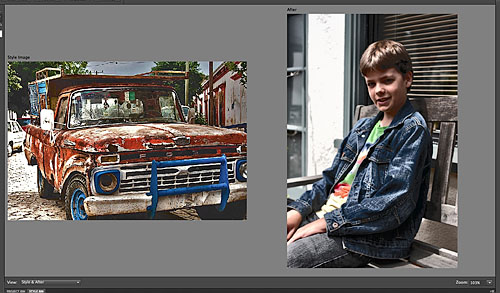
Style Match. Style (left) applied to image (right) with one click.
You can also paint and erase just the style from your image. And the style can even be another image. Gager used a scan of an Ansel Adams' shot of Yosemite (well, according to him, anyway; we're not sure which box of negatives he found it in) as the style for his similar shot of Yosemite, turning his color shot into a dramatic black and white.
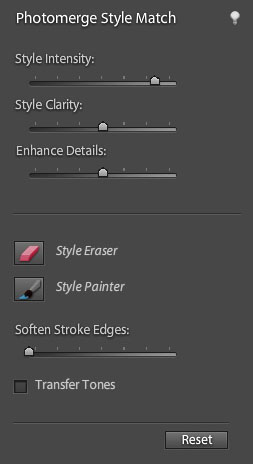
Style Panel. Fine control over the effect.
And just to show off a little (and get another gasp from his audience no doubt), he used a sunset image to turn his original taken at 10 a.m. into a romantic sunset shot (assuming you've got a room at the Ahwahnee Hotel, anyway).
How cool is that? Refrigerated, that's how cool.
SYSTEM REQUIREMENTS | Back to Contents
System requirements for Premiere Elements 9, the more demanding of the two applications, are:
- 4-GB installation space plus 5-GB content space
- Graphics card with updated drivers
- 1024x768 monitor at 96-dpi resolution
- DVD-ROM drive
- QuickTime 7
- FireWire/IEEE 1394 interface or a USB 2.0 interface
- Internet connection
Additional Mac system requirements include:
- Multicore Intel processor
- Mac OS X 10.5.8 or Mac OS X 10.6 or later
- 2-GB RAM
Addition Windows system requirements include:
- 2-GHz or faster processor with SSE2 support; 3-GHz processor for HDV or Blu-ray; dual-core processor for AVCHD
- Windows XP with Service Pack 2, Windows Media Center, Windows Vista or Windows 7
- Microsoft DirectX or 10 compatible sound and display driver
- Windows Media Player
For Photoshop Elements, the requirements are:
- 1-GB RAM or 2-GB for HD video
- 3-GB disk space for installation
- 1024x768 monitor at 96-dpi
- DVD-ROM drive
- Internet connection
- QuickTime 7
Additional Mac system requirements include:
- Multicore Intel processor
- Mac OS X 10.5.8 or Mac OS X 10.6 or later
- 2-GB RAM
Addition Windows system requirements include:
- 1.6-GHz or faster processor
- Windows XP with Service Pack 2 or 3, Windows Vista or Windows 7
- 16-bit video card minimum (you'll want a 24-bit video card)
- Microsoft DirectX 9 compatible display driver
Pricing remains the same. Retail pricing is $149.99 for the bundle or $119.99 with the mail-in rebate. Either product alone is $99.99 or $79.99 with the rebate.
But here's the deal. No prior purchase is required for the rebate, just the claim form in the box, proof of purchase tab and a copy of the sales receipt. Very nice.
There's a fine line between image magic and the Encyclopedia of Immaturity but Elements 9 keeps well clear of it with useful tricks for stills and amazing transformations for movies. And the price is ridiculous.
We've had only a couple of days to play with both updates, so we're sitting on our hands until we've had a chance to thoroughly test the new features. But when we do, we'll tell you all about it right here.
Meanwhile, what we've already seen is enough to cast a spell on us.
